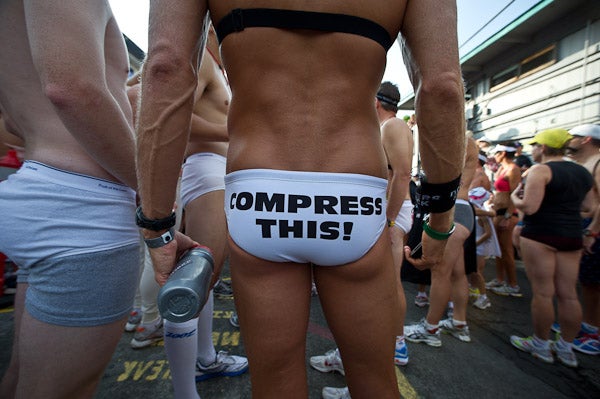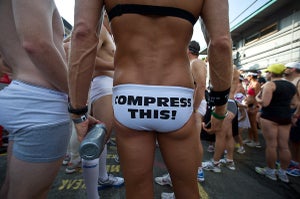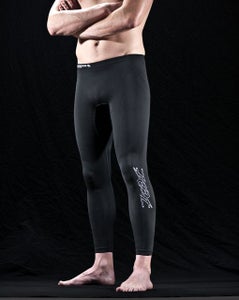Under Pressure: Does Compression Apparel Work?

Michael Lovato's take on compression wear. Photo: Nils Nilsen
Compression apparel has entered the triathlon mainstream, with pros and age-groupers alike donning specially engineered socks, sleeves and more to aid their training, racing and recovery. But does it really work?
Written by: Tawnee Prazak

At the 2010 Underpants Run in Kona, the phrase “Compress This” was plastered across the backside of a swim brief worn by pro triathlete Michael Lovato. Thought-provoking—in more ways than one.
The fact: Compression garments have infiltrated endurance sports. Triathletes of all skill levels are wearing the skintight pants, socks, tops and sleeves, creating quite the fashion statement. But the questions remain: Does compression really work? Or is it simply the placebo effect in play?
The truth: No one knows for certain. “What makes it tough is it’s so subjective,” says pro triathlete Andy Potts, who wears compression for recovery and during races. “Personally, I notice a difference,” he says. “I started wearing it in ’08 for recovery. Putting the socks on after pushing so hard is part of the process, one of the triggers to relax.”
Potts alludes to the increased feeling of comfort compression provides, which might be the one benefit anyone can really be sure about. In addition to promoting comfort, manufacturers of compression gear assert that their products can reduce muscle fatigue, boost performance and speed recovery. But just how bulletproof is the research?
“It’s highly debatable if there are any benefits,” says triathlon coach and exercise scientist Joe Friel. “[Research] is so varied with approaches to the pertinent topics—performance and recovery—that it’s hard to draw conclusions.”
That’s not to say compression apparel should be written off as a marketing gimmick; I wear it regularly, as do a lot of other triathletes. What is certain is that it’s worth digging deeper into the science and burgeoning trend of using compression clothing.
Some History

Compression made its debut in medicine more than 60 years ago to treat patients suffering from venous disorders (such as deep-vein thrombosis, or DVT) by enhancing circulation, reducing blood pooling, increasing deep-tissue oxygenation and more. “The population of people who have an issue with lymphedemga [blockage of the lymph vessels that drain fluid from tissues throughout the body] show good results,” says physical therapist Ron Gallagher. “Compression with chronic swelling and blood clotting has been shown to be effective as well.”
In the late ’80s researchers began investigating whether athletes could benefit from compression for the same circulatory reasons. A 1987 study in the American Journal of Physical Medicine showed that compression socks lowered blood-lactate levels after exhaustive exercise. Compression socks are believed to shuttle more blood deep into the leg to venous calf muscle pumps, allowing for less swelling and pooling—and less lactate. When compression garments are worn on other body parts, the potential benefits expand to include increased muscle response, reduced muscle oscillation, improved posture and form and enhanced efficiency and perception.
Promoting Recovery
Compression worn to promote recovery arguably has the most scientific backing. “I believe there may be recovery benefits—the primary of which is probably venous return from lower extremities,” says Friel, who wears compression for recovery after hard workouts and during air travel.
A 2007 study in the Journal of Sports Science showed that wearing compression reduced delayed-onset muscle soreness 24 hours after active males did 10K time-trial runs. Meanwhile, a study in the European Journal of Applied Physiology showed enhanced lactate removal with compression after trained males did max-effort cycling tests. And a 2009 study in The Journal of Strength & Conditioning Research reported that some subjects felt less muscle soreness when they wore compression tights after doing sprint, agility and jumping tests.
Conversely, other studies show rest and ice baths were more effective than compression for recovery, or that compression did not boost recovery.
Anecdotally, many triathletes love their compression for recovery. Heidi Austin and Chloe Elfrink are age-group triathletes whose jobs aren’t conducive to quality recovery, so both wear compression while working. “As a marketing rep I am always in my car,” says Elfrink. “Compression is a lifesaver after a 15-mile run when I have a six-hour drive. Adds Austin: “As a physical therapist I often spend eight to nine hours of my day on my feet. To survive both the workday and my workouts, I rely on compression to keep the calf muscle pump functioning optimally.”
Compression may get people back to training and racing in better form, but it doesn’t it end there. Or does it?
Performance Improvement
It’s a stretch to say compression will get you to the finish line faster. “I suspect there is no performance benefit,” says Friel, citing research and his real-life experience. The idea can’t be completely shunned, however.
Another 2009 study in The Journal of Strength & Conditioning Research found compression stockings improved running performance at submaximal intensities in moderately trained male runners. And a 2008 study on lower-body compression garments on cyclists in the International Journal of Sports Physiology and Performance reported increased power output and enhanced muscle oxygenation efficiency during shorter-duration cycling tests in well-trained male cyclists, but the same study found no performance gains in a one-hour time trial. In two studies of 10K time trial runs and 40-minute submax runs, the researchers in the 2007 Journal of Sports Science study measured many variables but showed only recovery benefits—no gains in performance.
Improving performance sometimes goes beyond time- and physiology-related variables. For those who’ve experienced injury or lower-limb issues, compression may act as a security blanket during activity. “After having a knee surgery to replace all of the torn ligaments in my knee, wearing compression during training gives me reassurance that everything is staying aligned and in place,” says Lauren Riley, an accountant training for Ironman. The reassurance Riley describes is a powerful mental component of compression that makes it “work”; it’s not as easy to quantitatively measure, but it’s effective.
The Placebo Effect?
The very idea that compression apparel works—and the confidence gleaned from that belief—is all the proof that many devotees need to justify their purchases. “Seeing pros using [compression products] and racing well adds to the age-groupers’ imagined probability of success,” says Friel. Andy Potts can’t cite specific markers of recovery or faster race times, but he still believes in compression. “They may not specifically add to physical performance, but the socks keep everything feeling in place,” he says. “They make training and racing not as ‘violent’ on the muscles. I think it’s worth the time to put them on [in T2]. For recovery, when the socks are on I’m not afraid of tweaking tendons, ligaments or muscles. I just elevate my feet and pay attention to getting blood flow back to the heart.”
Others, such as physical therapist Ron Gallagher, aren’t so easily convinced. “I think its effects are placebo,” he says. “We need to learn more about it.”
Bottom Line
Athletic compression is still in its infancy, and research to date is limited. There appears to be a better likelihood that it can help with recovery rather than with performance. The decision boils down to personal experience. If compression feels right for you and your needs, wear it. And if others give you a hard time, follow Michael Lovato’s lead and tell them: “Compress This!”
Tawnee Prazak (Tawneeprazak.com) CSCS, is a USAT-certified triathlon coach, personal trainer, exercise physiologist, triathlete and journalist.